|
Click pictures for a larger version.

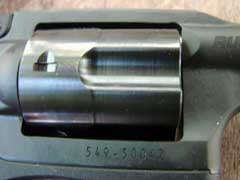


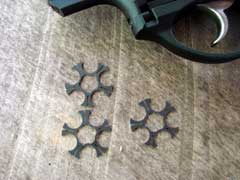

LCR 9mm comes supplied with three stainless steel moon
clips.
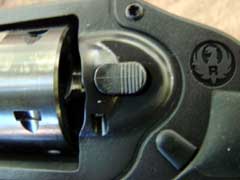


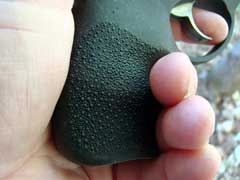
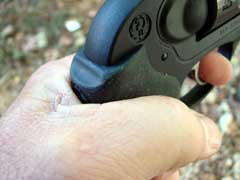
Hogue Tamer synthetic Monogrip.
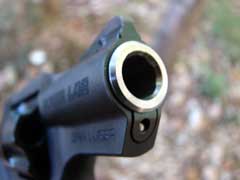

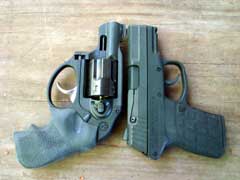
LCR (left) compared to Kel-Tec
PF-9 (right).
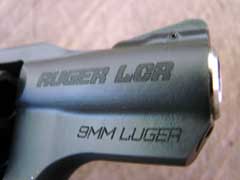
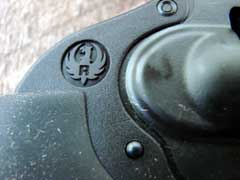
|
|
It has been nearly six
years ago that Ruger introduced their
then-radical new revolver, the LCR. The LCR made quite a
stir in the industry at the time, as it made extensive use of
polymer, combined with aluminum and stainless steel. Everything
about the LCR was non-traditional. The engineers threw tradition
out the window in designing the LCR, but the result was one of
the best pocket revolvers ever built. So far, I know of no one
who has sent off an LCR to Turnbull
Restorations for an engraving and case-hardening upgrade.
While Doug Turnbull and his crew do beautiful work, people do
not carry the LCR for its classic beauty. Some cruel people have
even called the LCR "ugly". The endearing thing about
the LCR is not its physical beauty, but its very smooth action
and light weight. The revolver rides comfortably in a pocket or
holster, and its smooth action makes it easy to fire, and to
fire accurately.
Since its introduction,
Ruger has added to the LCR lineup. In addition to the original
38 Special chambering, the LCR is now available chambered
for the 357 Magnum, 22
Long Rifle, and 22 Magnum
cartridges. There is also the LCRx
version in 38 Special, which has an exposed hammer, and the
action can be manually cocked for a single action trigger pull,
in addition to the smooth double-action pull for which the LCR
is best-known. The latest version of the LCR revolver (and there
are other versions in the works) is the five-shot 9x19mm shown
here.
Like the 357 Magnum LCR,
the 9mm version uses a blackened stainless frame. The grip
frame, which contains all of the fire control parts such as the
hammer and trigger, is still made of polymer, and of course the
barrel and cylinder are also made of stainless steel. The
stainless barrel is polished bright, and measures 1.875 inches
in length. The stainless cylinder is heavily fluted, as on other
LCR revolvers, and wears Ruger's Ionbond Diamondblack finish.
The 9mm LCR weighs almost four ounces more than the 38 Special
version. Listed at 17.2 ounces, mine weighs just a bit under
that at 17.1 on my scale. The
finger-groove Hogue Tamer Monogrip fits my hand perfectly. Like
the other versions of the LCR, the Crimson
Trace Lasergrip is an excellent option, having a very
effective laser sight built-in, and being just a bit more
compact than the Hogue. However, the Hogue is very comfortable
to use, taming the snappy recoil of Plus-P class loads.
The great advantage of the
9mm over the 38 Special in a pocket gun such as is this LCR is
that the 9mm uses moon-clips to easily load and unload the
revolver. The Ruger LCR 9mm ships with three five-shot moon
clips. The cartridges are very easy to load into and out of the
moon clips, with no tool needed to do so. Made of stainless
steel hardened to a spring temper, the moon clips should hold up
very well with use. The clips make it very fast and easy to load
all five chambers at once, and they unload easily as well,
enabling the user to catch the empty cases at once, losing none
on the ground.
While on that topic, we
might as well address the advantage of using a revolver instead
of an equally-compact semi-automatic. Many small autos are very
finicky about what ammo will cycle one-hundred percent reliably.
With a revolver, if it will chamber, it will fire, if it is good
ammo. The bullet shape does not matter. That is an advantage.
However, what I really like about using a revolver instead of an
auto is that it does not leave the empty brass cases on the
ground, which may or may not matter, depending upon the
circumstances. Many jurisdictions in this country still do not
allow for the legal carrying of a firearm. Just because it is
not legal to carry, does not mean that one has no need to carry.
If a person is forced to use a firearm for defense in a
jurisdiction where it is illegal to do so, it is not a good idea
to leave empty cartridges on the ground that are covered with
fingerprints. This does not mean that I am advising anyone to
carry a firearm where it is illegal to do so, it is just to
acknowledge that at times, it is a necessary thing to do, and in
such a situation, a revolver does not leave little calling cards
lying upon the ground. With
that out of the way, we need to address the reason for a 9mm
revolver to exist, when the same basic weapon is available
chambered for the 38 Special and 357 Magnum cartridges. The
most-compelling reason for me, is the ability to use moon clips
without extensive modification to the weapon. I
have had revolvers that are chambered for traditional rimmed
cartridges modified to use moon clips in the past, as the
weapons are much faster to reload, but doing so is an added
expense, and voids the manufacturer's warranty on the firearm.
Moon clips are even a bit faster than speed-loaders. The
relatively short, tapered cartridge of the 9x19mm makes it ideal
for use with moon clips, as the cartridges almost fall into the
chambers effortlessly.
Back to the features of the
9mm LCR, the front sight is pinned into place, making it easy to
replace with an XS Big Dot or other
tritium night sight, if desired. The rear sight is a squared
notch, mated with the serrated blade front, gives a sight
picture which is easy to get on target quickly. The front blade
has a white vertical insert, for easy visibility in low-light
situations, but I still recommend
an XS tritium front, Crimson Trace Lasergrip, or both on a
defensive handgun.
I was concerned that the
velocities of 9mm ammo fired from the Ruger's short barrel might
suffer greatly, compared to the velocities registered from a
three-inch barreled semi-auto, but that did not prove to be the
case. Even with the LCR's six one-thousandth (.006) inch
barrel/cylinder gap, the little revolver still registered
velocities almost the equal of those fired from a 3.1
inch barreled Kel-Tec semi-auto. Velocities from the
semi-auto registered an average of only about twenty
feet-per-second (fps) or so above those of the revolver, and in
a couple of instances, the LCR registered higher velocities.
This was very surprising to me, but that is why one should never
make assumptions based upon generalities.
Velocities were recorded
ten feet from the muzzle of the LCR, at an elevation of
approximately 541 feet above sea level. Temperatures hovered
around the seventy-three degree Fahrenheit mark, with relative
humidity of forty percent.
| Ammunition |
Bullet Weight |
Velocity |
| Federal
Guard Dog |
105 |
1106 |
| Double Tap TAC-XP |
115 |
996 |
| Double Tap FMJ |
147 |
990 |
| Atomic HP |
124 |
1100 |
| WCC NATO FMJ |
124 |
1069 |
| Fiocchi
FMJ |
115 |
1035 |
| Buffalo Bore FMJ-FN |
124 |
1201 |
| Buffalo Bore JHP |
115 |
1255 |
| Buffalo Bore +P JHP |
115 |
1287 |
| Buffalo Bore +P JHP |
147 |
1019 |
| Buffalo Bore TAC-XP |
95 |
1332 |
| Buffalo Bore TAC-XP |
115 |
1150 |
| Remington JHP |
124 |
1050 |
| Cor-Bon Glaser |
80 |
1503 |
| Cor-Bon JHP |
115 |
1267 |
| Cor-Bon
Pow’RBall |
100 |
1338 |
| Cor-Bon +P DPX |
115 |
1103 |
| Cor-Bon JHP |
125 |
1122 |
| Stryker JHP |
115 |
933 |
| International Cartridge FP |
100 |
1021 |
| Stryker FMJ |
115 |
989 |
| Liberty HP |
50 |
1857 |
The Ruger 9mm LCR
functioned perfectly. Every cartridge fired, and I experienced
no bullets walking forward under recoil. The little revolver
performed very well. With
a couple of the hotter loads, extraction was sticky, but with
most, the moon clip of empties fell out effortlessly. Perfect. I
also fired several rounds without using the moon clips. Again,
every cartridge fired as it should, but the cases had to be
manually extracted, as expected.
The Ruger LCR 9mm is a
dandy little pocket revolver, and it makes a lot of sense, as
reloads are much quicker than when loading cartridges
individually into each chamber. With practice, the little Ruger
revolver can be reloaded about as quickly as a semi-auto, and
carrying a couple of loaded moon clips in the pocket is an easy
way to carry spare ammunition. The moon clips are easy to load
and to unload without the use of a tool, yet when purposely
dropped onto concrete, the clip retained the cartridges
perfectly.
The suggested retail price
of the Ruger LCR 9mm revolver is, as of the date of this review,
$599 US, and the revolvers are in the distribution pipeline
right now, so if your dealer does not have one in stock today,
he should be able to get it within a couple of business days.
Like all Ruger firearms, the LCR is made in the USA.
Check out the new LCR 9mm
and other Ruger products at www.ruger.com.
To buy extra moon clips and
accessories for the LCR 9mm revolver, go to www.shopruger.com.
For the location of a Ruger
dealer near you, click on the DEALER FINDER at www.lipseys.com.
To order the LCR 9mm
online, click on the GUN GENIE at www.galleryofguns.com.
To
order quality 9x19mm ammunition, go to www.buffalobore.com,
www.doubletapammo.com,
www.midsouthshooterssupply.com,
and www.luckygunner.com.
Jeff Quinn
  
Got something to say about this article?
Want to agree (or disagree) with it? Click the following link to
go to the GUNBlast Feedback Page.
|
|
Click pictures for a larger version.
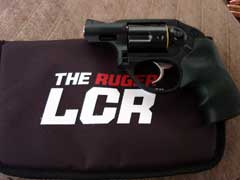
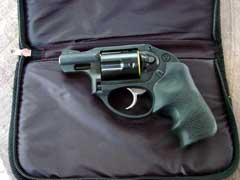
LCR comes with a padded, zippered storage case.
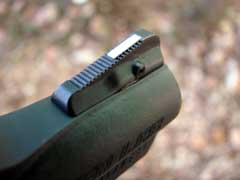
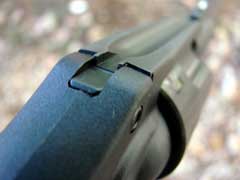

Ten-shot group, fired standing offhand at 15 yards.

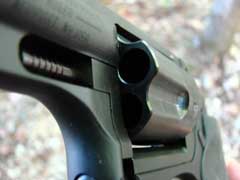

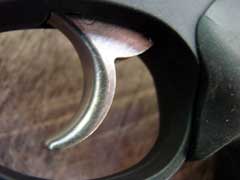

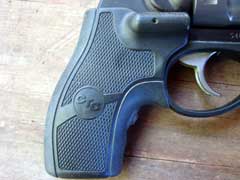
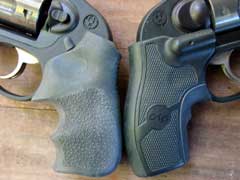
Crimson Trace Lasergrip is a useful addition to the
Ruger LCR, for easier use in low-light situations.
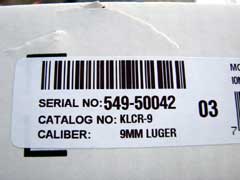
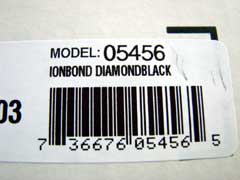
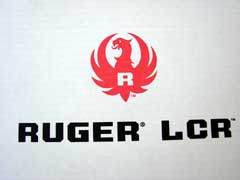
|
![]()